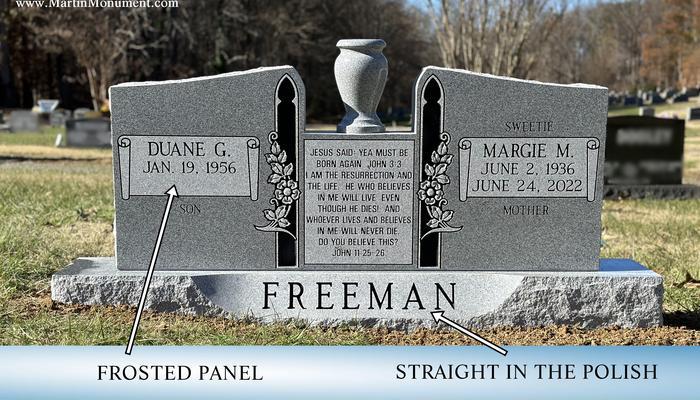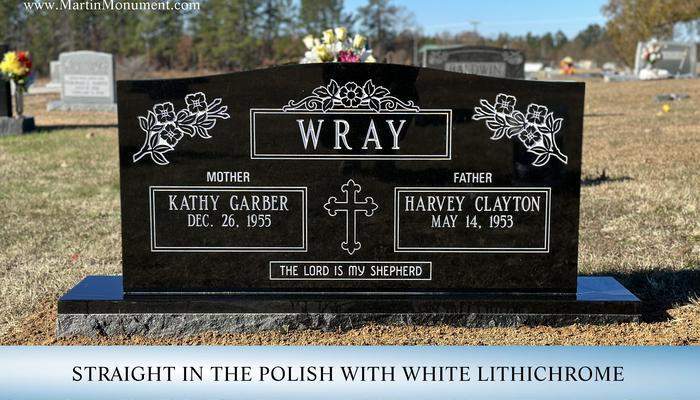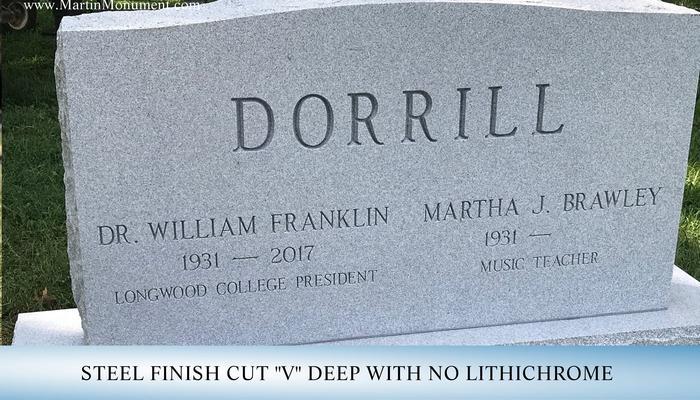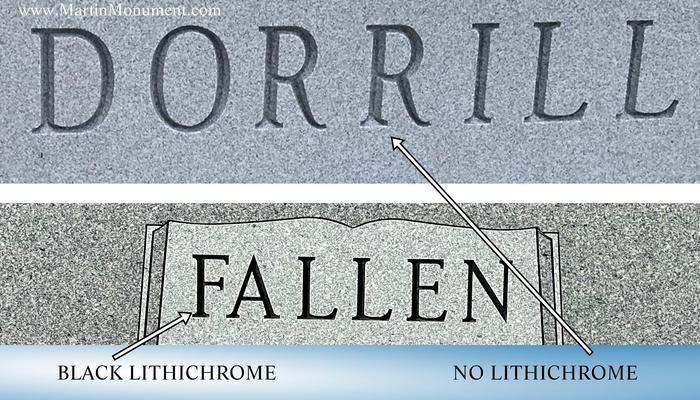|
When placing the panels on your monument you have the option to have frosted panels or straight in the polish. When we frost the panels, we remove the polish within the boundaries of the panel whether it be a bible, scroll or a simple rectangle. It gives the stone contrast between the various areas of the stone. Straight in the polish means that after engraving your details, we will usually apply lithichrome to highlight the letters and after cleaning the monument the process is complete and the text would appear without a frosted panel around the area.
|
|
Frosted Panel vs Straight in the Polish
On the Freeman stone you can see the difference between the frost panels and straight in the polish. On the die (upright section), you will see the frosted panels with the names along with their dates. When looking down at the base of the monument, you will see the family name "Freeman" is engraved into the monument base without a frosted panel surrounding it. The family name shown here was engraved within the chamfer which isn't polished with black lithichrome and no border. See the monument below to see the same technique with a polished surface.
|
Straight in the Polish
The option shown here on the Wray stone is straight in the polish with white lithichrome. There are no frosted panels and there are various colors of lithichrome available to suit your preference such as gold, silver and white being the most popular here in our office. The white lithichrome really stands out in the cemetery in contrast to the black stone.
| |
|
Frosted Panels with Lithichrome
The Reeve's stone shows frosted panels with black lithichrome applied to the lettering. The frosted panel against the dark polish on the stone looks really sharp and the black lithichrome in the text provides an extra shadow/highlight effect to the panels make the letters stand out.
|
Frosted Panel with No Lithichrome
On the Pearson slant you will notice the frosted panel and this features no lithichrome. When engraving this design we go extra deep cutting the letters to a nice deep "V" cut. By cutting this deeper this will help the natural light cast a shadow within the text to help better read the information similar to the highlight effect of the lithichrome. Over time, nature will run it's course and the letters will naturally darken without the need for any highlights. This provides a more classic look in the cemetery and one that's very popular. You will also notice the flowers and details here are shape carved adding another element to the design.
| |
|
Steel Finish
When you steel finish a monument the surface is smooth with texture, but not polished. To get this look, the stone surface is blasted with steel shot until is reaches a flat textured surface. This is always a classic all natural look without the need for lithichrome.
|
Rock Pitch vs Polished
During the design process, you will have the opportunity to choose the appearance of the top and sides of your monument. Polished means the surface will be very smooth. Rock pitch a more natural look where you see the rough edges of the rock where it's hand pitched with a chisel. If choosing a polish 2, the front and back of the stones will be smooth while the top and the left and right edges are rock pitch. On a polish 3, the top, front and back would be smooth while the left and right sides are rock pitch. The final option is a polish five or an all polish meaning just that, all sides; front, back, top, left and right are all polished.
| |
|
Base Options
Just like the die, you will have the option to choose the base to match your monument. Typically we recommend a rock pitch base that has a polished top with your monument unless you're purchasing a polish 5 (all polish) die. In that case we recommend a base with a polished margin as shown in the photo. You can choose any base you'd like but those are just the guidelines we usually advise our customers. There are several other options as well such as an all polish, name chamfers and beveled fronts depending on your preferences.
|
This will all come down to personal preference but we can offer some guidance. Lithichrome stone paint is used to darken the letters on monuments to make them easier to read. The paints are formulated to last forty plus years however this is not guaranteed. Depending on the location of the stone, how much sunlight hits the letters, the weather abuse it receives and other natural factors. Ultra-violet light in sunlight is the chief source of pigment and binder deterioration. Lithco Colors are compounded from the most sunlight-resistant pigments and resins known.
Arlington National Cemetery states on their website: "The first headstones at Arlington National Cemetery were simple white headstones with the personal information and gravesite number etched into the stone. Later, lithochrome — a type of water-resistant paint applied to headstones that darkens the letters — was introduced to make inscriptions easier to read. Over time, the blackening fades. The fading occurs in a non-uniform way, both on individual headstones and across a section. Arlington National Cemetery no longer uses lithochrome, except for on headstones ordered for first interments (at the time of interment) located in Section 60, as well as on niche covers in columbarium courts 1-9 and the niche wall. If a headstone requires replacement for another reason, it will not contain lithochrome. When niche covers are in need of replacement, lithochrome will be applied."
If you choose to go with no lithichrome, the text will naturally darken over time with pollen, dust, dirt and the outdoor elements. Walk through various cemeteries and you will notice of the older stones how many are easily legible when lithichrome wasn't available. If you have any questions, we're more than happy to answer them for you.
|
|
|
|
|













